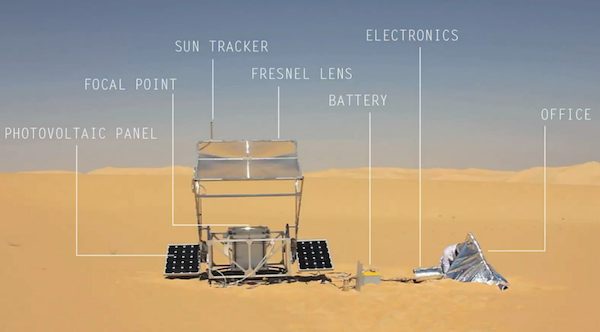
Screen shot from video of Markus Kayser’s Solar Sinter equipment demonstrating 3D printing using a natural raw material—sand—and solar power. Credit: Popular Science.
Those of us who celebrate Christmas may have received a spiffy new gadget as a gift and are having a great time learning how to use it. For those who are “gadgeteers,” the annual International Consumer Electronics Show (CES) wards off the post-holiday doldrums.
CES 2014 runs next week, Jan. 7–10, in Las Vegas, N.V. I can’t go, but with more that 150,000 attendees expected from 150 countries to visit 3,200 exhibitors, I doubt I will be missed.
But I will be following it. In particular, I’ll be watching for news from the 3D printing exhibit area, apparently the first time the technology will be exhibited in a dedicated area of the show. According to 3D news and CES-watcher, 3ders.org, CES expanded the area three times to accommodate demand for the sold-out floor space. Among the 27 (at least) vendors, are some of the most familiar names in the 3D world, including Stratasys, Mcor Technologies, MakerBot, and 3D Systems.
Along with the show, there will be a conference track on 3D technologies. The Jan. 7 track, “Impact of the 3D Printing Revolution,” is a panel discussion featuring founders and CEOs of 3D companies, including Mcor Technologies and MakerBot. The Jan. 8 track, “Don’t Believe the Hype? 3D Printing Uncovered,” looks at whether 3D is really a game-changer, how and why, and who is leading the charge.
The description of the panel discussion claims “worldwide sales of products and services are poised to reach $3.7 billion by 2015 in a field that is moving in many directions.” That is a lot of money—read opportunity— and explains some other activity rippling around out there. The market research company, Market Research, just released a new report analyzing the industry from every angle and offers forecasts into 2018. The report covers plastics, metals, and ceramics.
For example, the legal skirmishes have begun. Gigaom reported yesterday that Stratasys sued Afinia claiming infringement on four patented technologies: heated platform, extruder, seam hiding, and infill rate and pattern. According to the report, “If Afinia is found to have violated any of these patents, it would spell trouble for other 3D printing companies. All four are ideal features to have in a 3D printer, and there are likely more companies out there in Afinia’s boat. A ruling in Afinia’s favor, or even a large settlement, would dampen work being pursued by smaller 3D printing companies.”
Smaller enterprises smell opportunity, too. A small shop called Boots Industries out of Quebec City, Canada, turned to Kickstarter to finance their 3D printing kit that they say consumers can assemble themselves (video) in less than an hour. Among the system’s innovations is an integrated LCD controller, which eliminates the need for a computer. Kits will start shipping to investors this year.
Finally, it’s always interesting and, in my opinion, informative to see how the art and design community embraces technological ideas. These free-thinkers are smart, creative, and—being free of the constraints of a product-driven economy—ask some interesting questions about what technology can do. Sure, some of it won’t amount to anything more than a curiosity satisfied, but the “what if” thinkers challenge assumptions and bring a different view.
Take London-based design student Markus Kayser, for example. He designed a solar-powered 3D printer to sinter sand to see if he could make glassware using just solar energy and lenses. Given the dearth of sun and sand in London, he took his 200 pounds of equipment, which he calls Solar Sinter, to Egypt and set it up in the Sahara Desert. This six-minute, time-lapse video shows Solar Sinter at work—which did indeed make several 3D printed glass objects from Sahara sand. (A Popular Science article describing the work dispels any notion that this young man is not an engineer at heart.)
Will Kayser’s idea go anywhere? Who knows? Maybe on the moon?
